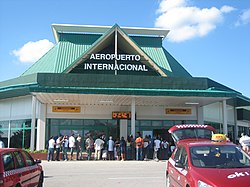Frank País Airport
|
Frank País Airport Aeropuerto Frank País |
|||||||||||
|---|---|---|---|---|---|---|---|---|---|---|---|
 |
|||||||||||
| Summary | |||||||||||
| Airport type | Military/Public | ||||||||||
| Operator | ECASA | ||||||||||
| Serves | Holguín | ||||||||||
| Location | Holguín, Holguín Province, Cuba | ||||||||||
| Elevation AMSL | 110 m / 361 ft | ||||||||||
| Coordinates | 20°47′08″N 076°18′54″W / 20.78556°N 76.31500°WCoordinates: 20°47′08″N 076°18′54″W / 20.78556°N 76.31500°W | ||||||||||
| Map | |||||||||||
| Location in Cuba | |||||||||||
| Runways | |||||||||||
|
|||||||||||
Frank País Airport (Spanish: Aeropuerto Frank País) (IATA: HOG, ICAO: MUHG) is an airport serving Holguín, a city in the Cuban province of Holguín. It bears the name of Cuban revolutionary Frank País. The airport was built in 1962 initially only for military purposes before civilian air operations began in 1966. It consists of a domestic and an international terminal, which was built in 1996 and expanded in 2007.
The aviation history of Holguín originates in a makeshift runway built near the Hill of the Cross (Spanish: Loma de la Cruz) in the city. Domingo Rosillo landed on this airstrip in 1914, one year after becoming the first pilot to fly between Key West and Havana. The first official airport serving Holguín was inaugurated on 30 October 1930. On this day, the airport served as one of several stops on the first airmail route in Cuba, between Havana and Santiago de Cuba. The airport was located in the neighbourhood of Peralta and named after mambí General Julio Grave de Peralta. However, because there was often dense fog at the airport, it closed a few years afterward; and operations moved to another site close to the location of the current airport.
In 1962, a military airbase was established on the outskirts of the city. Civilian air operations shifted to an area within the base on 10 November 1966, thus establishing Frank País Airport. As the tourism sector in Guardalavaca grew during the early 1990s, there was a need for a new international terminal, which was constructed in 1996 by Canadian infrastructure company Intelcan Technosystems. In 2007, the capacity of the terminal was doubled to 1,200 passengers per hour through a 1,300-square-metre (14,000 sq ft) expansion, which took one year to complete. Carried out to reduce congestion in the terminal during peak season, the expansion included additional customs facilities and a new VIP lounge. The inauguration of the expanded facilities was presided over by politician Miguel Díaz-Canel.
...
Wikipedia

